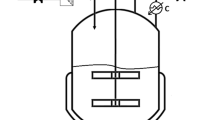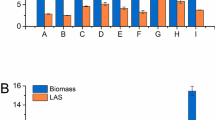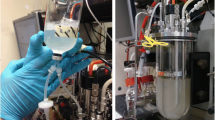Abstract
Production of lipopeptides fengycin and surfactin in rotating discs bioreactor was studied. The effects of rotation velocity and the addition of agitators between the discs on volumetric oxygen transfer coefficient k L a were firstly studied in model media. Then the production of lipopeptides was also studied at different agitation conditions in the modified bioreactor (with agitators). The effect of agitation on dissolved oxygen, on submerged and immobilized biomass, on lipopeptide concentrations and yields and on the selectivity of the bioreaction was elucidated and discussed. The proposed modified rotating discs bioreactor allowed to obtain high fengycin concentrations (up to 787 mg L−1), but also better selectivity of the bioreaction towards fengycin (up to 88 %) and better yields of fengycin per glucose (up to 62.9 mg g−1), lipopeptides per glucose (up to 71.5 mg g−1), fengycin per biomass (up to 309 mg g−1) and lipopeptides per biomass (up to 396 mg g−1) than those reported in the literature. Highest fengycin production and selectivity were obtained at agitation velocity of 30 min−1. The proposed non-foaming fermentation process could contribute to the scale-up of lipopeptide fermentors and promote the industrial production of fengycin. The proposed bioreactor and bioprocess could be very useful also for the production of other molecules using bioprocesses requiring bubbleless oxygen supply.







Similar content being viewed by others
References
Gancel F, Montastruc L, Liu T, Zhao L, Nikov I (2009) Lipopeptide overproduction by cell immobilization on iron-enriched light polymer particles. Process Biochem 44(9):975–978
Chtioui O, Dimitrov K, Gancel F, Nikov I (2010) Biosurfactants production by immobilized cells of Bacillus subtilis ATCC21332 and their recovery by pertraction. Process Biochem 45:1795–1799
Jacques P (2011) Surfactin and other lipopeptides from Bacillus spp. In: Soberon-Chavez G (ed) Biosurfactants, Microbiology Monographs 20. Springer-Verlag, Berlin
Arima K, Kakinuma A, Tamura G (1968) Surfactin, a crystalline peptidelipid surfactant produced by Bacillus subtilis: isolation, characterization and its inhibition of fibrin clot formation. Biochem Biophys Res Commun 31:488–494
Ongena M, Jacques P, Toure Y, Destain J, Jabrane A, Thonart P (2005) Involvement of fengycin-type lipopeptides in the multifaceted biocontrol of Bacillus subtilis. Appl Microbiol Biotechnol 69:29–38
Ongena M, Jacques P (2008) Bacillus lipopeptides: versatile weapons for plant disease biocontrol. Trends Microbiol 16:115–125
Ongena M, Jourdan E, Adam A, Paquot M, Brans A, Joris B, Arpigny JL, Thonart P (2007) Surfactin and fengycin lipopeptides of Bacillus subtilis as elicitors of induced systemic resistance in plants. Environ Microbiol 9(4):1084–1090
Deravel J (2011) Caractérisation des lipopeptides d’origine non ribosomique comme biopesticides. Ph.D. Thesis, University of Lille 1, France
Ramkrishna S (2010) Biosurfactants Ramkrishana. Springer Science + Business Media, New York
Sivapathasekaran C, Mukherjee S, Sen R, Bhattacharya B, Samanta R (2011) Single step concomitant concentration, purification and characterization of two families of lipopeptides of marine origin. Bioprocess Biosyst Eng 34:339–346
Veenanadig NK, Gowthaman MK, Karanth NGK (2000) Scale up studies for the production of biosurfactant in packed column bioreactor. Bioprocess Eng 22:95–99
Yeh MS, Wei TH, Chang JS (2006) Bioreactor design for enhanced carrier-assisted surfactin production with Bacillus subtilis. Process Biochem 41:1799–1805
Lee BS, Kim EK (2004) Lipopeptide production from Bacillus sp. GB16 using a novel oxygenation method. Enzyme Microb Technol 35:639–647
Coutte F, Lecouturier D, Ait Yahia S, Leclere V, Bechet M, Jacques P, Dhulster P (2010) Production of surfactin and fengycin by Bacillus subtilis in a bubbleless membrane bioreactor. Appl Microbiol Biotechnol 87:499–507
Chtioui O, Dimitrov K, Gancel F, Dhulster P, Nikov I (2012) Rotating discs bioreactor, a new tool for lipopeptides production. Process Biochem 47:2020–2024
Fahim S, Dimitrov K, Gancel F, Vauchel P, Jacques P, Nikov I (2012) Impact of energy supply and oxygen transfer on selective lipopeptide production by Bacillus subtilis BBG21. Bioresource Technol 126:1–6
Tribe LA, Briens CL, Margaritis A (1995) Determination of the Volumetric Mass Transfer Coefficient (k L a) Using the Dynamic “Gas Out-Gas In” Method: analysis of Errors Caused by Dissolved Oxygen Probes. Biotechnol Bioeng 46:388–392
Guez JS, Muller CH, Danze PM, Buchs J, Jacques P (2008) Respiration activity monitoring system (RAMOS), an efficient tool to study the influence of the oxygen transfer rate on the synthesis of lipopeptides by Bacillus subtilis ATCC 6633. J Biotechnol 134:121–126
Morikawa M (2006) Beneficial Biofilm Formation by Industrial Bacteria Bacillus subtilis and Related Species. J Biosci Bioeng 101(1):1–8
Nakano MM, Dailly YP, Zuber P, Clark DP (1997) Characterization of anaerobic fermentative growth of Bacillus subtilis: identification of fermentation end products and genes required for growth. J Bacteriol 179:6749–6755
Hussein W (2011) Study on the regulation and biosynthesis of fengycin and plipastatin produced by Bacillus subtilis. Ph.D. Thesis, University of Lille 1, France
Liu Y, Tay JH (2001) Metabolic response of biofilm to shear stress in fixed-film culture. J Appl Microbiol 90:337–342
Acknowledgments
Financial support for this work by ARCIR program of the regional council of Nord-Pas de Calais, France, is gratefully appreciated. Authors also thank Dr F. Coutte (ProBioGEM laboratory) for the kindly provided standards of surfactin and fengycin.
Author information
Authors and Affiliations
Corresponding author
Rights and permissions
About this article
Cite this article
Chtioui, O., Dimitrov, K., Gancel, F. et al. Selective fengycin production in a modified rotating discs bioreactor. Bioprocess Biosyst Eng 37, 107–114 (2014). https://doi.org/10.1007/s00449-013-0964-9
Received:
Accepted:
Published:
Issue Date:
DOI: https://doi.org/10.1007/s00449-013-0964-9




